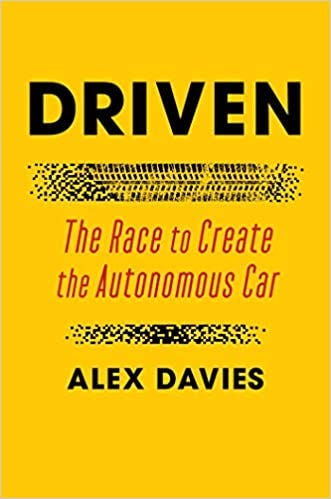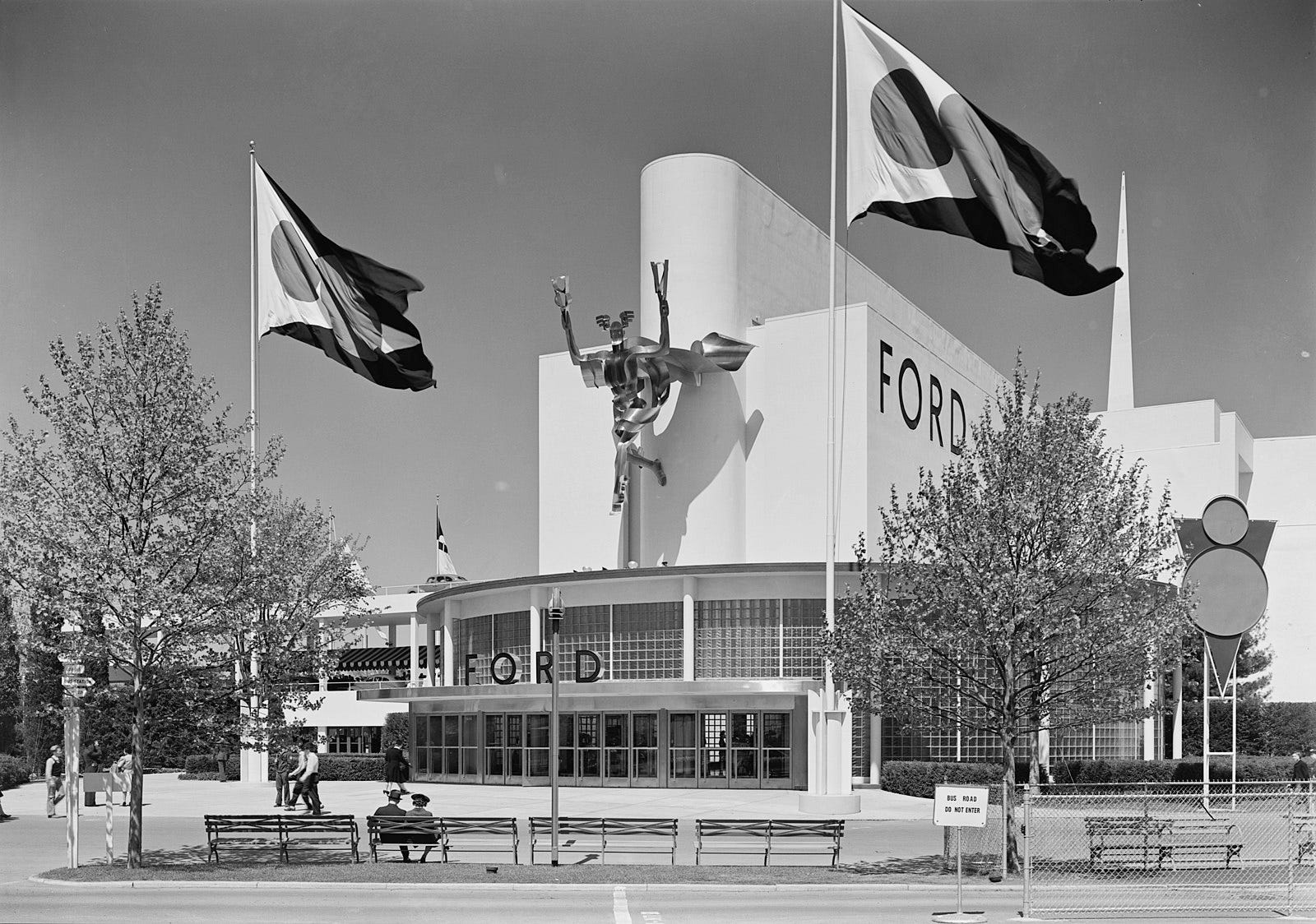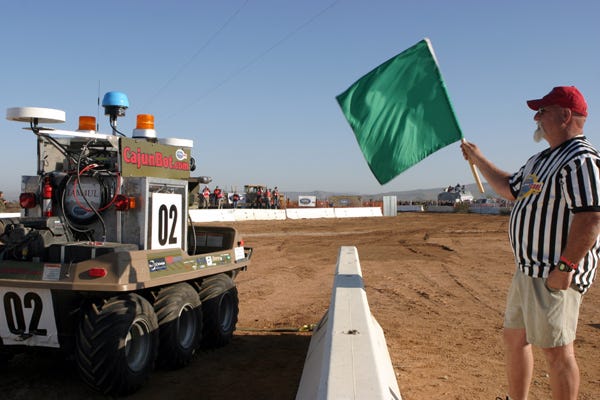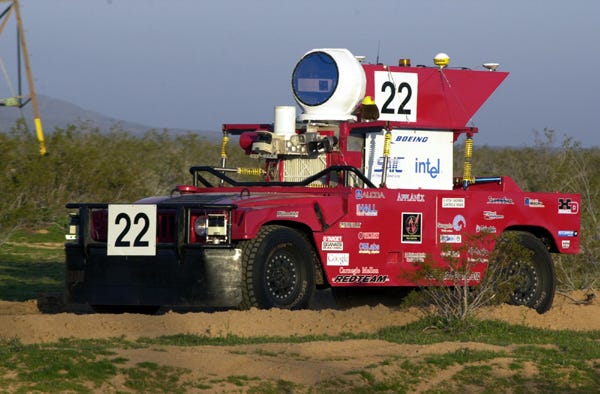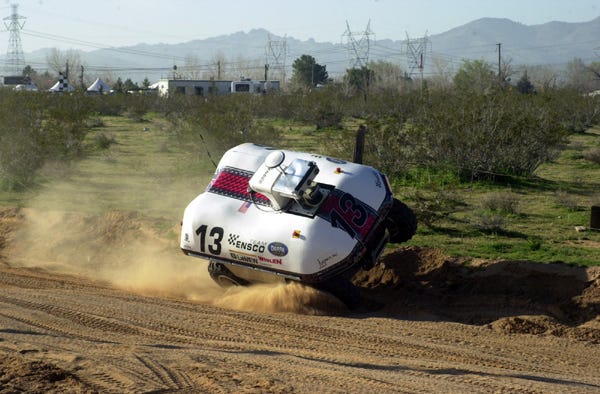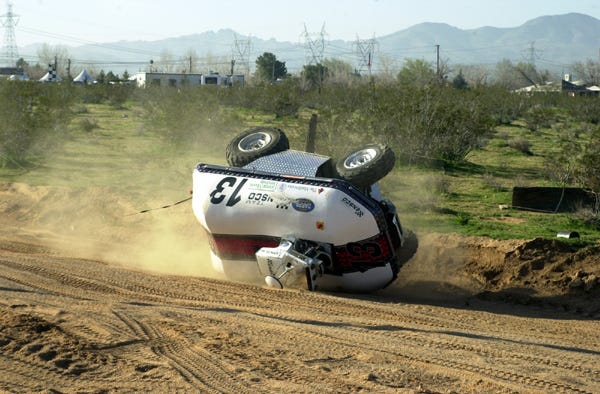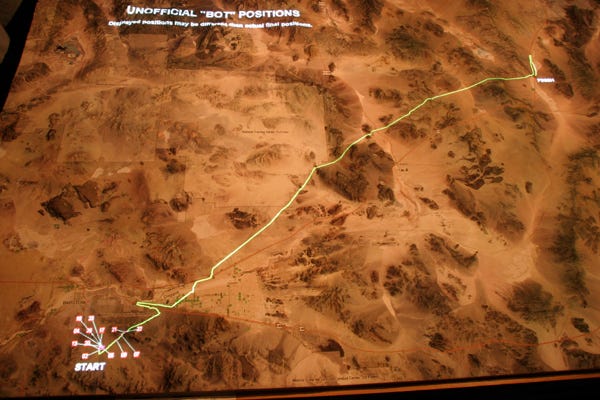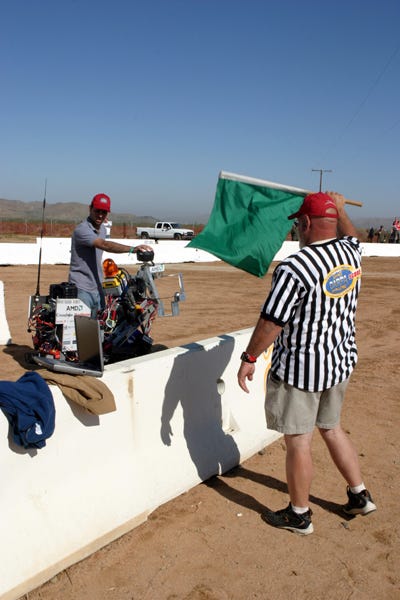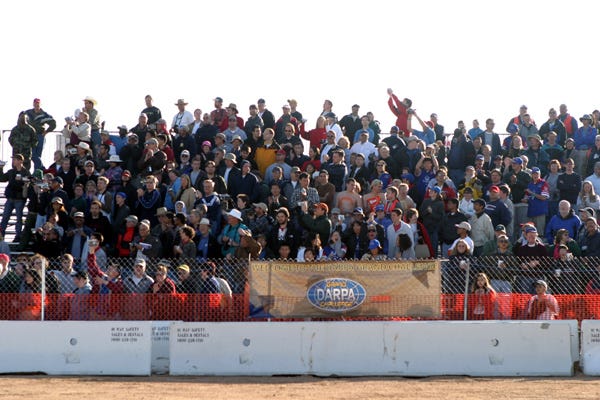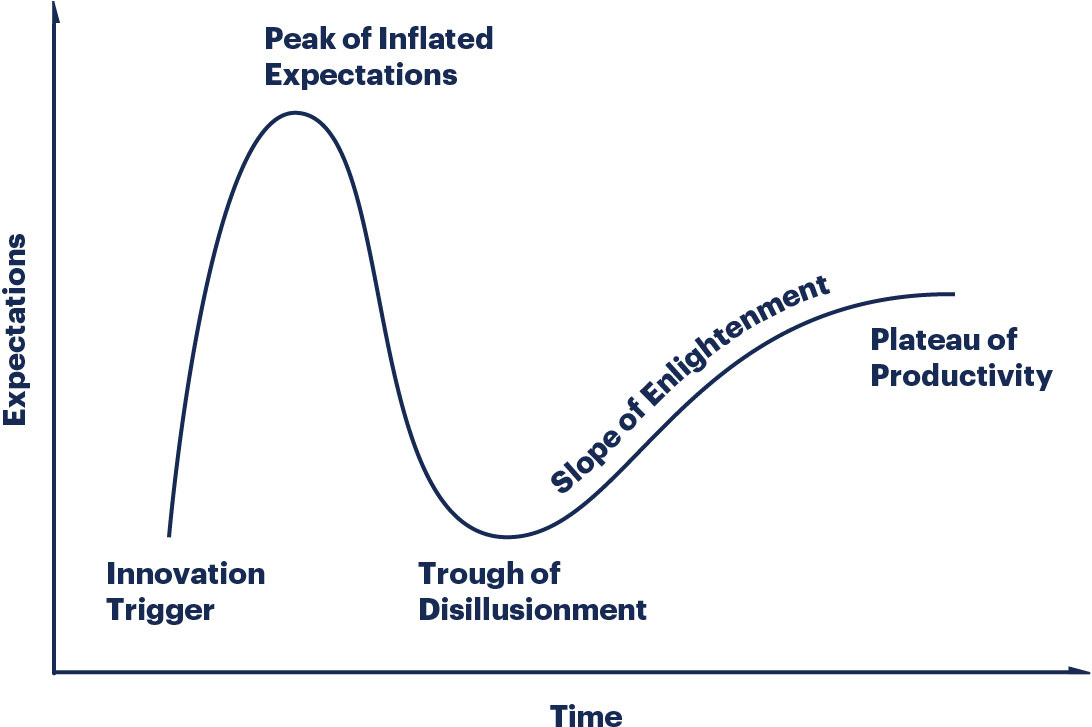By Walt Hickey
Welcome to the Numlock Sunday edition. Each week, I'll sit down with an author or a writer behind one of the stories covered in a previous weekday edition for a casual conversation about what they wrote.
This week, I spoke to Alex Davies, the author of the brand new book Driven: The Race to Create the Autonomous Car. It’s just out as of last week and is an enthralling read about the events that led us to the present-day state of the art of autonomous vehicles.
I’ve been looking forward to this book since it was announced, and it doesn’t disappoint: from the iconic if shambolic 2004 DARPA Grand Challenge to the legal battles that threatened to tear the industry apart, the creation of this tech could change the world. It’s a great story.
For the first time, I recorded one of these to be podcast-quality so you can actually listen to the interview up top. Let me know if you enjoy that, and maybe I’ll do more of them!
The book is Driven: The Race to Create the Autonomous Car and can be found wherever books are sold, and Alex is on Twitter at @adavies47.
This interview has been condensed and edited. Unless otherwise indicated, images are from DARPA. Podcast theme by J.T. Fales.
Alex, you are the author of the brand new book, Driven: The Race to Create the Autonomous Car. You cover all about transportation, you cover all about vehicles and you've also covered a lot about the technology that goes into them. There's been a lot of talk about driverless cars recently, you were talking about how this is a really long journey. How far back have we been working on driverless cars?
I think the people first started talking about the driverless car right around the time people came up with the car itself. The car was a great invention for all sorts of reasons but one thing people noticed very quickly was that when you got rid of the horse, you got rid of the sentient being that would stop you from driving off a cliff or into a wall if you, the human driver, stopped paying attention. You see these stories from the ‘20s and ‘30s of people coming up with ways of remote-controlling cars using radio waves. And in the ‘50s, you start seeing programs from General Motors and RCA working on embedding electric strips into the road, which obviously didn't work for various reasons, that would help guide a car along the highway. You see examples from the 1939 and 1964 World's Fairs in New York where GM is talking about, "oh, cars that will drive themselves and you'll have these things like air traffic controllers saying, okay, your car is clear to go into self-driving mode," or back then they would have used the word autonomous.
Ford Pavilion, 1939 World’s Fair, via Library of Congress
So, the idea itself is really old but technologically, I think you've got to date this work from the ‘70s, ‘80s and ‘90s. That's when you first start seeing the technology that undergirds the way we think about building self-driving cars today, which is not by following any kind of radio path, nothing built into the infrastructure and the system, but the basic idea of giving the car the tools it needs to drive itself the way a human operates a car.
You've got three basic buckets: one is you have to recreate a human’s senses, so that's where you see things like cameras, radars, LiDAR sensors, giving the car the ability to see the world around it. You have to replace what a human's arms and legs do or hands and feet, really, and those are just kind of servo motors built into the car that give the car the ability to turn the steering wheel or pump the gas and brakes. And, actually, in today's cars, that's all done purely over software, it's not even really mechanical in there anymore. And then the last, the really tricky thing is how do you replace the human's brain? The step between the senses and actually carrying out the decisions you need to make.
I start my story with the 2004 DARPA Grand Challenge. I give a little bit of the history of the robotics and artificial intelligence research that happened before it. But for me, the Grand Challenge is really the starting point. DARPA is that really kooky arm of the Pentagon that is basically charged with making sure the U.S. government is never surprised on the technological front. It came out of the Soviets launching Sputnik, which really shocked the Americans to hell, and they're like, “okay, we need an arm of the military that's just going to do the kooky kind of far out stuff.” So DARPA, a lot of big hits — the internet, GPS, stealth bombers. Some not so great moments — DARPA was instrumental to the creation of Agent Orange. Whoops.
Oops, yeah no, don't want to do that one.
That one, not so nice.
Look, they're not all hits, they're not all hits and that's okay. We are friends, we have been friends for a while now. I feel like you have told me the story of the 2004 DARPA Grand Challenge many times, as this deeply formative event, not only for self-driving cars but also robotics and Silicon Valley and how government can work together on different things. Do you want to go into what went into creating this event and kind of what happened at it? Which I feel like is a very, very cool story that I imagine is a solid chunk of the book.
It is a solid chunk of the book. It's also, personally, my favorite part of the book. To me, this is really the heart of the story. DARPA was tasked with helping the U.S. military develop autonomous vehicles and the basic thinking there was that vehicles were a way a lot of soldiers got hurt, especially in the early 2000s, as we were starting to get mired down in these wars in Iraq and Afghanistan. We wanted autonomous vehicles so soldiers didn't have to be in vehicles that were being hit by IEDs, so you could send cars by themselves on convoys and dangerous missions, and basically, it was to save the lives of the troops. DARPA had been funding all sorts of research into autonomous driving for decades by this point and the guy running it, DARPA director Tony Tether, was frustrated that he just wasn't seeing the kind of progress he wanted to see, it just felt like one internal research project after another.
So, he said, “do you know what?” DARPA had, at the time, a relatively new power to give out prize money and he could give out up to a million dollars without needing congressional approval. So, he created a thing called the DARPA Grand Challenge with a $1 million first prize. It was a race for autonomous vehicles across the Mojave Desert in California. You would go from this real dusty little town called Barstow in the California Mojave Desert to just across the line to Primm, Nevada, which is a pretty sad town because it's the least driving you have to do from California to legally gamble in a casino. If you're like, “I don't have the energy to drive the extra 45 minutes to Las Vegas,” you go to Primm.
Oh no.
And so, Tether's original idea, very briefly, it was we're going to have the cars go from Los Angeles to the Las Vegas Strip and they'll go on the freeway. And the guy at DARPA who was actually in charge of putting on this race was like that is completely insane, you can't do any of that. These robots don't work, we don't even know what they're going to look like. So, they ended up doing it in the desert, which made more sense for the military application anyway when you think about what your driving in the Middle East would be like. But the key part of the challenge was that it was open to anybody, this was not just Lockheed Martin and Boeing and Carnegie Mellon University, the big contractors who had been doing this kind of work. Tony Tether just said, “anybody who can build a self-driving car, we’ll bring them all to the desert and we'll do this big race.” And so, you see this wide range of characters who come into this.
I think, foremost among them, interestingly, is Anthony Levandowski, who at the time is just about 23 years old. He’s an graduate student at UC Berkeley and he decides he really wants to be in this because he loves robotics, even though he doesn't have a ton of robotics training. He's like, “I'm going to build a self-driving motorcycle.” So, that's his idea. You've got the big players like Carnegie Mellon and that's where Chris Urmson, who becomes Anthony Levandowski's great rival once they're both at Google years later, comes in. Chris Urmson is a big player, Carnegie Mellon is the robotics powerhouse in the world, probably the best roboticists in the world and have been doing tons and tons of self-driving research over the decades. They field this team as a powerhouse of a team and you've got this guy, Red Whittaker, who's the old roboticist there.
This is amazing.
I have been yelled at by Red Whittaker more times than I care to remember.
Really!
He's just very cantankerous, he's an ex Marine, he's now 70 years old, he's well over six feet, he's 250 pounds, the guy is built like a redwood and he's just always yelling. And he builds robots, someone pointed this out to me once, he builds robots that look like him, in a sense. They're always these enormous, hulking things and for the Grand Challenge, they built this Humvee. And Red Whittaker, someone told me, he has this penchant for saying really bombastic things that sound crazy and don't actually make any sense. So, he once told someone, this project, it's like a freight train, you've just got to grab on and it'll rip your arms off.
It sounds terrible.
When he told me this, it's like, what does that even mean? But he has this incredible talent for really developing young engineers. And Chris Urmson is among his many proteges who are now pushing this technology into the world.
And so, you have this collection of wacky racers, gathering to win a million dollars from the Defense Department in the desert. And the first one is 2004, what happens at the first one?
It is a disaster. The 2004 DARPA Grand Challenge is supposed to be a 142 mile race through the desert, 15 teams get out of a qualifying round and make it to the final round. If you looked at the qualifying round, vehicles were smoking and shaking or they couldn't even start at all or they were just driving into every last thing.
And then the race in the desert itself, wasn't all that much better. It got off to a great start, Carnegie Mellon's Humvee, Sand Storm, was first off the line, it shoots off into the desert. So, it's doing okay, the first couple of vehicles get off the line okay. And then you get through the bottom half of the field and it becomes a comedy of errors. You've got one little bathtub shaped thing that goes up onto the tiny ridge just on the side of the trail where it's raised and flips over and lands upside down.
You've got one that drives 50 yards out, does an inexplicable U-turn and drives back to the starting line. We've got one, one just veers off-road into barbed wire and then can't find it's way back. You've got this thing from OshKosh that's a 14 ton military truck, a six wheeled thing, it's lime green and it's got a tumbleweed, like a bush thing in front of it. And its detection system says, this is an unmovable obstacle, but then another tumbleweed shows up behind it and so, it just starts going forward and backward and forward and backward like Austin Powers, trying to turn around.
And then, even Carnegie Mellon's vehicle, which is doing well and is seven miles into the race, it's going around a hairpin turn, it goes off the edge of the road a little bit and it gets hung up on this rock. It gets, basically, stranded like a whale on a beach. It's raised up to the point where its wheels can't get any traction anymore. The robot brain doesn't know this and it's just spinning its wheels, spinning its wheels at full speed until the rubber is on fire and smoke pouring off this thing. And DARPA has to show up from a helicopter. They hop out of the helicopter with the fire extinguishers, and it's a complete disaster.
And the thing that DARPA had really hyped up, they're like, “this is the new innovation, we're going to save the lives of all these troops.” And so then, reporters come after Tony Tether and he meets them, he meets the reporters who are waiting at the end line, at the finish line, which is roughly — it's 142 mile race — 130 miles away from the closest car.
The Outcome.
Carnegie Mellon did the best, it went 7.4 miles. Anthony Levandowski's motorcycle makes it into the final round, mostly as a stunt. It did horribly in qualifying, but the DARPA guys are like, “this thing is so crazy, it really embodies the spirit of what we're trying to do, so let's just bring it to the race anyway.” It's not like it can win, its gas tank doesn't hold enough gas for it to go all the way to the finish line.
So, Anthony brings it up to the starting line, hands it off to a DARPA guy who kind of holds his hand on it until it goes, motorcycles starts going, he takes his hand off and motorcycle instantly falls to the ground. Anthony had forgotten to turn on the stabilizing software system before it started.
That will get you.
And so, one of his lessons for the next year was make a checklist.
The cool thing about this is that it's an utter fiasco, it's how you always tell it. But then everybody who was there for this fiasco, they stuck around and they went, in many ways, to kind of form the current self-driving industry. Do you want to talk about that seed, what it has turned into since?
Yeah. So, very quickly, what's great about the Grand Challenge is that it brings all these people together, and it pits them against this problem that everyone had kind of dismissed as impossible. So, what happens is DARPA does the 2005 Grand Challenge 18 months later, and the 18 months really prove to be the difference in that teams that weren't ready at all for the Grand Challenge, for the original one, are ready 18 months later. They've learned much more about how this works. And so, the 2005 race is a huge success. Stanford, led by Sebastian Thrun, comes in first place, Carnegie Mellon second, five teams finish this big race through the desert. Then DARPA follows it up with the 2007 Urban Challenge, which pits the vehicles against a little mock city, where they have people driving around and all of a sudden they have to deal with traffic and stop signs and parking lots and all of this stuff.
What you really get from the Urban Challenge is the sense that this technology seems, suddenly, very possible. And by 2007, this is a big media event, it's hosted by the guys who did MythBusters and Larry Page is there, and he shows up in his private plane full of Google execs, and it's like, look at this future of technology.
About a year later, Larry Page wants to build self-driving cars. This is actually something he'd looked at as an undergraduate or a graduate student and then his thesis advisor said, “well, how about you focus on internet search instead?” And it worked out pretty well.
It worked out okay, I think, right?
I think he did fine, that's what I thought.
He decided I want to get back to self-driving cars. He'd been at the Urban Challenge and been like, “I can see how far this technology has come,” so what he did was he went to Sebastian Thrun, who had led Stanford's team through the challenges and he was already working at Google, he was a big part of making Street View happen. Along with Anthony Levandowski, who Thrun had met through the challenges and he's like, “oh, this guy's nuts but he's really talented and he's a real go-getter.” So, he brings him on to help them do Street View and then Larry Page says, “okay, now build me a self-driving car.” Sebastian Thrun says, "okay, well I happen to know the 12 best people on the world at this technology, I met basically all of them through the DARPA challenges."
He has this meeting at his chalet in Lake Tahoe, at the end of 2008. And he brings together a dozen people and it's Anthony Levandowski and it's Chris Urmson and then people like Bryan Salesky — names that are now really the top tier in self-driving cars. And he says, “Google is going to build a self-driving car, we're going to have something that looks a whole lot like a blank check and I want this team to be the one to do it.” And that becomes Project Chauffeur. They become this really secretive project within Google, they go forth over the next couple of years, and they make this incredible progress in self-driving cars. And this is the story of the second half of the book: how this team it comes together and then how they ultimately come apart because as soon as they have to start thinking about how to make a product, how to commercialize this technology and the reality of money and power within the team become real wedge issues.
Within them, you see rivalries, especially between Urmson and Levandowski, who are fighting for control and fighting for the direction of the team. Ultimately, things kind of break apart and what you see over time is as people leave and as this technology starts to look a lot more real, everyone splinters off to do their own thing, and this was what I call Google self-driving diaspora. Chris Urmson leaves to start Aurora. Bryan Salesky leaves to start Argo. Dave Ferguson and Jiajun Zhu leave to start Nuro, Don Burnette leaves to start Kodiak, and Anthony Levandowski, of course, leaves to start Otto, which is acquired by Uber, which is the genesis of the Uber-Waymo huge self-driving lawsuit.
Considerable amount of litigation that I believe is ongoing to this day, yes.
So, the litigation did end, fortunately for everyone but the lawyers, I think. Uber and Waymo ultimately settled and then, weirdly, about a year after that, the Department of Justice charged Levandowski with criminal trade secret theft to which he ultimately pled guilty, and a few months ago he was sentenced to 18 months in prison, but he will not start his sentence until the pandemic is over.
So, it definitely seems that this is still very much seen as the start of something, and you have covered a lot of this industry. What's kind of the state of the art now and where are things kind of moving forward?
Well, fortunately for the industry, all of these personal rivalries, I think, have largely cooled off. And I think the book is really a history of how this got started and how these people pulled this technology forward, and then kind of came apart at the seams. But now what you've got is something that looks a little bit like a mature industry. You have Waymo with its program in the Arizona suburbs of Phoenix, and it’s starting to really take the safety drivers out of its cars in earnest. Cruise, which is also a focus of the book, which is part of GM and also backed by Honda, is moving to take the safety drivers out of its cars in San Francisco, a much more dynamic environment, as it moves to start a self-driving system there. Self-driving trucks are looking much more serious than ever before. Argo AI, which has partnered with Ford and Volkswagen, is moving towards starting a taxi service, a robo-taxi service in Miami.
I talk about the Gartner hype cycle where, I think, from 2014 to 2017 or so, we were really at peak hype, totally inflated expectations where everyone said, “your kids will never have to learn how to drive.” Chris Urmson is saying, "my 12 year old son will never have to learn to drive a car," and I'm pretty sure the kid’s got his learner's permit by now. Those inflated expectations burst a little bit as people realize just how hard this technology is. But I think where we are now, on that Gartner hype cycle, is on what's called the slope of enlightenment, where people are getting more serious. Even if they haven't cracked the problem yet, I think they have a really good sense of what it takes to crack the problem, which, it turns out, is a lot of time, an incredible amount of money and at least 1,000 very talented engineers.
Whole lot of lasers, a very sympathetic governmental oversight structure in a suburb of Phoenix. We have the ingredients for the solution, right?
We could make it work. And so, I'm still optimistic about it, I still think the technology can do a lot of good. I think what people are figuring out is how to right-size this technology. People are figuring out how to actually apply self-driving cars in a realistic way, and I think the cooler projects out there are companies that are working on making self-driving shuttle cars for senior living communities, these big areas in Arizona and Florida, they cover 1,000 acres and people need to get around but can't necessarily drive anymore. And where the driving environment is pretty calm, that's a great use case. The trick right now is to figure out where you can make the technology work, and then the next question will be where can you actually make money off of this? That one I'm less bullish on because the economics of this, I think, are going to be pretty tough to crack.
I mean, we're closing in on the end of this one, but DARPA seeded a little bit of the initial funds, it seems, for a lot of this research. Is that still an application that people are looking into or getting folks off the road in places that are dangerous?
The army is still working on that, and I think those projects are still ongoing. But the initial push for DARPA was a line in a congressional funding bill from the end of 2000, it was one of the last things Clinton signed into law. And it mandated that by 2015, one-third of all ground vehicles, I think it was military, be unmanned, which was completely insane.
How did we do? What's the number?
I mean, maybe we've got three vehicles. That stuff hasn't panned out so much. But my favorite thing, one of the first people I managed to track down for this book was the guy, the congressional staffer who got that line into the bill. And I told him, I was like, "oh, I'm researching this and I would just want to ask you about why you put that in there and what your thinking was."
And he goes, "Oh, did something come of that?"
That's amazing.
I was like, “yeah, I don't know, an industry that's predicted to be worth $7 trillion.”
And what also came of it is Driven: The Race to Create the Autonomous Car by Alex Davies. Alex, where can people find the book?
You can find this book, basically, anywhere online, it's available through Amazon, Barnes and Noble, your regular booksellers. It's out in hardcover January 5. You can also get the audiobook, you can get it on Kindle. Get it however you like, I just hope you enjoy it.
My Twitter handle is @adavies47. You can find some of my work on Business Insider, where I'm the senior editor for our transportation desk.
Ah, excellent website, very, very good website.
If you have anything you’d like to see in this Sunday special, shoot me an email. Comment below! Thanks for reading, and thanks so much for supporting Numlock.
Thank you so much for becoming a paid subscriber!
Send links to me on Twitter at @WaltHickey or email me with numbers, tips, or feedback at walt@numlock.news.




